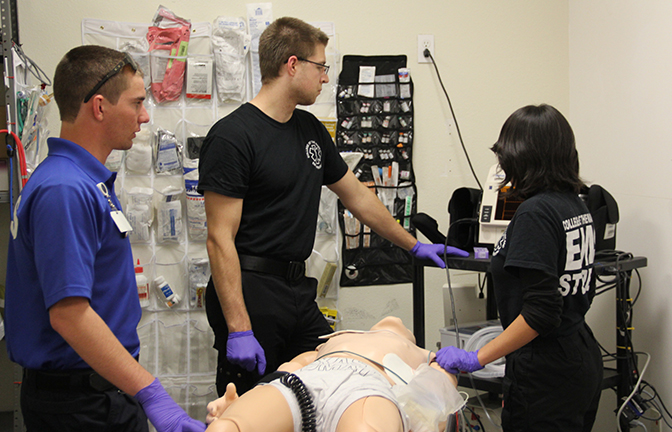Prepare to save lives with COM EMT program

Emergency medical technicians can restart a heart, administer medications and insert an IV, all in an ambulance flying at 80 miles per hour.
In the College of the Mainland Emergency Medical Services Program, students learn how to save a life in situations where each second counts.
Kellen Wood works with Dickinson Emergency Medical Services and is a COM instructor.
“No day is the same,” said Wood. “A woman gave us a blue baby and said, ‘Save my baby.’ I’ve delivered babies. I’ve gotten kids unstuck from vending machines. You think you’ve seen it all, then something else comes along.”
Students in the COM EMS Program discover how to respond to situations from cardiac arrest to car accidents. They learn dozens of medications and their effects, how to perform CPR and how to insert a breathing tube.
“You are learning how drugs work at a molecular level,” explained Wood. “It’s a lot of memorization plus knowing that on the job you have to be cool as a cucumber.”
COM offers EMT-basic and EMT-intermediate certificates, which each take a semester to complete. Graduates who progress to earn the three-semester paramedic certificate will enjoy the most job opportunities.
The past two years, COM paramedic classes have had 100 percent pass rates on certification exams.
Graduate Hope Jensen, 18, of Friendswood, completed the EMT-Intermediate Program. She’s now working at the Alvin Emergency Medical Services Department while she completes the COM Paramedic Program.
“You never know what you’re going to show up to. The clinicals prepare you so much for it,” said Jensen. “The first thing we’re taught is it’s not your emergency (so you don’t panic). You’re here to help.”
In the EMS program, students perform clinicals, ride on ambulances and visit hospitals' emergency and operating rooms. They also learn on the SIM man, a robotic manikin that can “breathe,” have a changing pulse and respond to students’ treatments.
The hours of training ensure that when students arrive on scene they’re ready.
Ultimately, emergency medical services is about treating and reassuring each patient, said Wood.
“People don’t thank you for the medical attention. They thank you for bringing order to chaos,” said Wood. “It’s the worst day of someone’s life, and they’re looking to you to make it better.”
For more information on COM Emergency Medical Technician Program, visit www.com.edu/ems.
